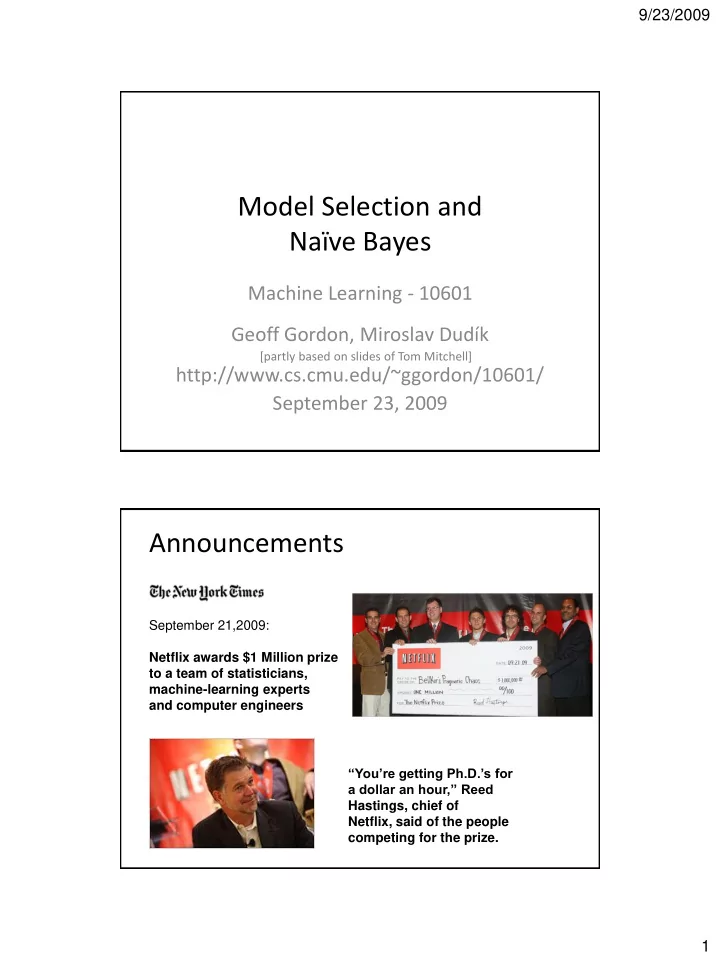

9/23/2009 Model Selection and Naïve Bayes Machine Learning - 10601 Geoff Gordon, Miroslav Dudík ([[[partly based on slides of Tom Mitchell] http://www.cs.cmu.edu/~ggordon/10601/ September 23, 2009 Announcements September 21,2009: Netflix awards $1 Million prize to a team of statisticians, machine-learning experts and computer engineers “You’re getting Ph.D.’s for a dollar an hour,” Reed Hastings, chief of Netflix, said of the people competing for the prize. 1
9/23/2009 How to win $1 Million Goal: (user,movie) -> rating Data: 100M (user,movie,date,rating) tuples Performance measure: root mean squared error on withheld test set How to win $1 Million A part of the winning model is the “baseline model” capturing bulk of the information: [Koren 2009] 2
9/23/2009 How to win $1 Million training set quiz set test set FAQ: why quiz/test split? We wanted a way of informing you … about your progress … while making it difficult for you to simply train and optimize against “the answer oracle” 3
9/23/2009 FAQ: why quiz/test split? Two goals for withholding data • model selection • model assessment training set validation set test set What if data is scarce? 4
9/23/2009 Cross-validation • split data randomly into K equal parts Part 1 Part 2 Part 3 • for each model setting: evaluate avg performance across K train-test splits evaluate error Part 2 Part 3 Part 1 evaluate error Part 3 Part 1 Part 2 evaluate error • train the best model on the full data set The best model… Depends on the size of the data set: y ≈ w 0 + w 1 x + w 2 x 2 + w 3 x 3 + w 4 x 4 + … + w 10 x 10 5
9/23/2009 K -fold cross-validation trains on of the training data Controlling model complexity • limit the number of features • add a “complexity penalty” 6
9/23/2009 Regularized estimation min error train (w) + regularization(w) min -log p(data|w) - log p(w) Examples of regularization min min 7
9/23/2009 training error training regulari + error zation regularization L 2 : L 1 : L 1 vs L 2 L 1 • sparse solutions • more suitable when #features much larger than training set L 2 • computationally better-behaved How do you choose λ ? 8
9/23/2009 Announcements HW #3 out due October 7 Classification Goal: learn a map h: x y Data: ( x 1 , y 1 ), ( x 2 , y 2 )… , ( x N , y N ) Performance measure: 9
9/23/2009 All you need to know is p(X,Y) … If you knew p(X,Y) , how would you classify an example x ? Why? How many parameters need to be estimated? Y binary X described by M binary features X 1 ,X 2 ,…,X M Data: p(X,Y) described by numbers 10
9/23/2009 Naïve Bayes Assumption • features of X conditionally independent given class Y Example: Live in Sq Hill? • S=1 iff live in Sq Hill • D=1 iff drive to CMU • G=1 iff shop in Sq Hill Giant Eagle • A=1 iff owns a Mac 11
9/23/2009 Naïve Bayes Assumption • usually incorrect… • Naïve Bayes often performs well, even when the assumption is violated [see Domingos-Pazzani 1996] Learning to classify text documents • which emails are spam? • which emails promise an attachment? • which web pages are student home pages? What are the features of X ? 12
9/23/2009 Feature X j is the j th word Assumption #1: Naïve Bayes 13
9/23/2009 Assumption #2: “Bag of words” “Bag of words” approach 14
9/23/2009 15
9/23/2009 16
9/23/2009 17
9/23/2009 What you should know about Naïve Bayes Naïve Bayes • assumption • why we use it Text classification • bag of words model Gaussian Naïve Bayes • each feature a Gaussian given the class 18
Recommend
More recommend